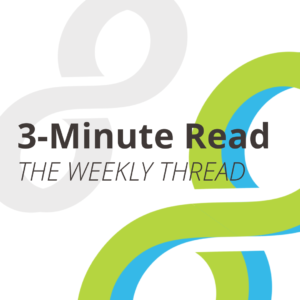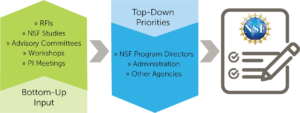From Application to Award: Navigating NSF’s Funding Calls
 April 3, 2023 — The U.S. National Science Foundation (NSF) funds about a quarter of all federal research to U.S. colleges and universities. In an average year, NSF issues 12,000 competitive research awards, supports around 2,000 universities and other institutions, and aids over 300,000 researchers, entrepreneurs, students, and teachers.
April 3, 2023 — The U.S. National Science Foundation (NSF) funds about a quarter of all federal research to U.S. colleges and universities. In an average year, NSF issues 12,000 competitive research awards, supports around 2,000 universities and other institutions, and aids over 300,000 researchers, entrepreneurs, students, and teachers.
NSF funding is one of the largest driving forces behind U.S. basic and use-inspired research, and new efforts from the Technology, Innovation and Partnerships (TIP) Directorate are on track to fund more technology translation research as well. But how, exactly, does it work? Knowing how NSF develops its funding calls can inform whether researchers in academia and industry pursue publicly funded opportunities. As more opportunities emerge from U.S. federal agencies for multi-sector research collaboration, the mechanics of the process matter more now than ever.
NSF’s proposal calls begin with a research idea generated from top-down or bottom-up sources, as illustrated in the graphic below. Top-down ideas arise from a priority identified by NSF, the administration, or other agencies. Bottom-up development is more organic, leveraging the expertise of the external research community and gathered from peer-reviewed papers, workshops, or other collaboration inputs. NSF encourages all stakeholders to participate in the information-gathering process and is eager to increase engagement with industry in particular. Knowledge gaps and areas of interest that can advance innovation in an entire industry sector are extremely valuable for NSF to understand.
The idea is then considered for partnership and collaboration with other government agencies, companies, and nonprofits. In one collaboration model, joint solicitations, companies are encouraged to directly partner with NSF and participate in the discussion of the scientific scope of a funding call as well as other important elements required for a successful project.
After the call is finalized, it is published in either a Dear Colleague Letter (DCL) or a funding solicitation. DCLs are less formal and may not necessarily be a direct call for proposals. They highlight existing or emerging research areas or invite the research community to participate in other collaborative activities like workshops and conferences.
Formal solicitations are an official request for research proposals. They outline specifications for proposals, including the funding opportunity, scope of research, amount of funding available, and eligibility requirements.
After the funding opportunity announcement, NSF accepts proposals from researchers across the country, and the proposal and award process begins. A minimum of 90 days is required for a principal investigator to respond to a proposal, and the actual review and processing phase may take up to six months to complete. If a proposal is funded, it goes on to the next step: award processing. Usually, the award is made within 30 days of approval, although additional time may be needed if the organization hasn’t received funding before, the award is a cooperative agreement, or it involves other special situations. Find out more about proposal and award policies here.
Why it matters
Great ideas are the genesis of NSF research funding, and community input helps shape NSF funding priorities. Expertise from the research community is integral to the funding development process. When a research lead from industry or academia provides critical information to NSF on a topic in their wheelhouse, they get a voice in future research funding. Corporate input offers real-world perspective on the value and direction of research, which can accelerate translation of basic research into the goods and services that help solve societal challenges.
We want to hear from you: How does your organization engage with NSF? Have you contributed to any NSF funding calls or RFIs? Let us know on our LinkedIn profile.



